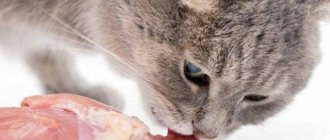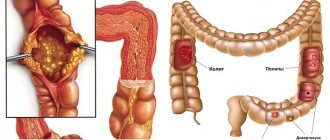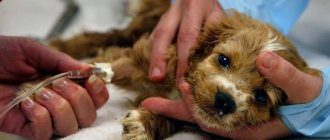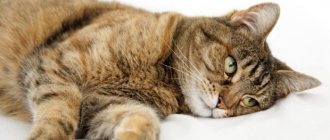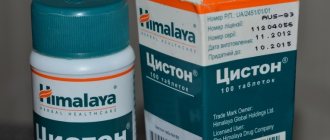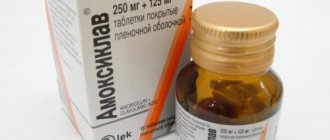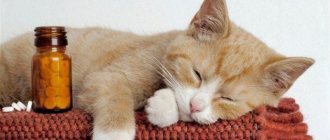7646Pavel
2
Owners of furry meowing pets may encounter any deviations or disturbances in the health of their pets. This deviation can be loose stools in cats, or, more simply, diarrhea. Can cats take Loperamide? – a question that arises among owners who urgently want to help their pet, but do not have suitable medications for animals in their veterinary medicine cabinet.
Diarrhea in cats can occur due to poisoning, poor diet, infection, parasites, allergies or gastrointestinal diseases. As a result of prolonged diarrhea, the cat becomes dehydrated, which threatens to impair blood circulation in the brain. For this reason, the alarming and dangerous symptom should be immediately eliminated, and Loperamide can help with this.
© shutterstock
Action of Loperamide
Diarrhea in cats is a fairly rare occurrence, but can occur with certain disorders in the gastrointestinal tract. In veterinary medicine, there are not many drugs for this disease, and therefore sometimes veterinarians are forced to use medications intended for humans to treat animals. Loperamide is a human drug used for digestive disorders and diarrhea . Its action is to suppress intestinal receptors that are responsible for peristalsis: the contraction activity of the intestine decreases and its walls relax.
Loperamide should be given to cats only in extreme cases, when progressive diarrhea threatens dehydration, and other remedies do not help. It should also be remembered that in case of poisoning, Loperamide does not fight toxins, but inhibits their release through feces. This means that treatment for diarrhea in cats must be comprehensive and aimed not only at suppressing the symptoms, but also at their cause. Loperamide is an available analogue of Immodium.
Composition of the drug:
- Loperamide hydrochloride (active ingredient);
- Starch;
- Talc;
- Lactose;
- Magnesium stearate;
- Aerosil.
Loperamide for a cat with diarrhea may not be needed if the cause of diarrhea is not related to poor diet or allergic intolerance to any product. In such cases, treatment consists of a special diet and elimination of allergic foods. But if a cat’s loose stool is associated with poisoning, a disease of the digestive system or a parasitic infection, then complex treatment of the animal will be required under the supervision of a specialist, using Smecta, which is an excellent absorbent agent.
This is interesting: How much does a Thai kitten cost?
Loperamide for cats - indications and dosage
Owners of furry meowing pets may encounter any deviations or disturbances in the health of their pets. This deviation can be loose stools in cats, or, more simply, diarrhea. Can cats take Loperamide? – a question that arises among owners who urgently want to help their pet, but do not have suitable medications for animals in their veterinary medicine cabinet.
Diarrhea in cats can occur due to poisoning, poor diet, infection, parasites, allergies or gastrointestinal diseases. As a result of prolonged diarrhea, the cat becomes dehydrated, which threatens to impair blood circulation in the brain. For this reason, the alarming and dangerous symptom should be immediately eliminated, and Loperamide can help with this.
© shutterstock
What is Loperamide
The active substance included in the drug ensures the release of two substances - prostaglandins and acetylcholine, which suppress diarrhea and relieve spasm of the intestinal walls . Loperamide binds to opioid receptors in intestinal cells, causing it to “calm down.”
The second mechanism of Loperamide's effect is an increase in the tone of the anal sphincter, which helps to retain feces and reduce the frequency of the urge to defecate .
The drug also prevents the removal of electrolytes from the body - potassium and chlorine ions. This helps maintain water-salt balance and prevents dehydration.
Effect on the body
The drug is intended for relief
that are not caused by an infectious disease or
intestines. Loperamide is the drug of choice for the treatment of chronic diarrhea, which is caused by emotional or allergic factors, changes in habitual diet, etc. The drug also successfully relieves diarrhea that developed during the use of other medications and painful symptoms
. It should be clearly understood that Loperamide is not a panacea for any type of diarrhea. The drug is effective only for the relief of non-infectious diarrhea, which can be caused by a variety of factors: for example, in some people the cause of diarrhea is excitement, in others, trying a new delicious dish at a party or in a restaurant, an allergic reaction, etc.
The slightest suspicion of diarrhea of infectious origin is a contraindication to the use of Loperamide. If diarrhea is infectious, then it is necessary to take antibiotics that will destroy the causative agent of the disease. In this situation, the remedy can eliminate diarrhea, thereby slowing down the removal of toxins from the human body, which will lead to negative consequences.
Loperamide has an affinity for receptors located in the intestinal wall. As a result of its effect on receptors, the medication reduces the tone and motility of the intestinal muscles. Due to the decrease in activity, the movement of intestinal contents slows down. At the same time, the drug increases the tone of the anal sphincter, which allows it to retain feces longer.
Also, under the influence of the medicine, the frequency of the urge to have a bowel movement is significantly reduced. Loperamide acts very quickly - within one hour after administration, which is necessary for it to enter the intestines and bind to receptors. The duration of action of one tablet or capsule is from 4 to 6 hours, and this period is determined solely by the individual characteristics of the human body. A single dose of Loperamide is completely eliminated from the body within 12 hours.
Usage and dosage
The dosage of the drug is calculated from the following recommendations: a tablet in a dosage of 0.05-0.1 mg for every 400 g of the pet’s weight. The maximum time of use of the drug is 48 hours. If taking the medicine does not cause improvement, then you should contact your veterinarian. The required dosage of Loperamide should only be given orally.
We invite you to read Conscientious Misconceptions - Euthanasia of Animals
There are cases when the use of the drug may be hampered by specific behavioral signs of the cat. Under no circumstances should you give medication if:
- the pet is weakened;
- poisoning has occurred with toxic substances;
- a painful attack is observed;
- the cat bears offspring or feeds kittens;
- kittens up to one year old;
- the presence of an infectious disease in the animal;
- for kidney pathology, etc.
You should never experiment and combine several drugs yourself.
The estimated dosage is 0.05-0.1 milligrams per kilogram of weight. For one-year-old kittens take 0.1 mg/kg, for adult animals - 0.05 mg/kg, this is done due to the higher metabolism of small pets. The drug is administered orally regardless of feeding (with a small amount of food possible).
It is not recommended to use Loperamide at home for more than 2 days, as this can lead to unpleasant consequences. Loperamide should not be given to kittens under 2-3 months of age, as their body will react excessively. Use with caution in six-month-old animals.
Loperamide: instructions for use - how to take capsules or tablets
Loperamide tablets or capsules from all manufacturers are taken according to the same rules that apply to this drug. The capsules are swallowed with a small amount
. The tablet is placed under the tongue, where it dissolves within a few seconds, after which all the saliva in which Loperamide has dissolved is swallowed. Do not take the tablet with water.
Loperamide dosage regimens differ for children and adults.
Adults and teenagers over 12 years old. For acute illness, take 2 capsules (4 mg) or 2 tablets (4 mg) orally, at a time. Then, after each bowel movement with loose stool, take one tablet or one capsule. The maximum allowable amount of Loperamide that can be taken per day is 16 mg, which is equivalent to 8 capsules or tablets.
To treat chronic diarrhea, adults take 2 capsules or 2 tablets of Loperamide daily. If necessary, the daily dose can be increased to 8 capsules or tablets. The dosage is selected individually so that the frequency of stool does not exceed 1 - 2 times a day.
Children. When acute diarrhea develops, a child 6–8 years old immediately takes one capsule or tablet of Loperamide (2 mg). Then, after each subsequent bowel movement with loose stools, the child should take half a tablet or half a capsule (1 mg). A dosage of Loperamide of 1 mg after each loose stool is recommended by pediatricians in Russia, although the manufacturers of the drug believe that it is necessary to take 2 mg of the drug - that is, one whole tablet or capsule.
The maximum daily dose for children is 6 mg, or 3 tablets (capsules), according to the data and observations of domestic pediatricians, and 8 mg, or 4 tablets (capsules), according to the recommendations of the Loperamide manufacturers. For the treatment of chronic diarrhea in children 6–8 years old, the drug is used in a daily dose of 2 mg, which corresponds to one tablet or capsule. If necessary, the daily dose can be increased to 3 capsules or tablets, which is equivalent to 6 mg of the drug.
We invite you to read: Black cat with green eyes: description, color features, photo
For the treatment of acute diarrhea, children aged 2 to 5 years take Loperamide at a dose of 1 mg (half a tablet), 3 times a day. It is not recommended to give the drug in capsules to children under 6 years of age - it is better to use tablets. Children 9–12 years old can take the drug 2 mg (1 capsule or tablet), 3 times a day.
Elderly people should dose Loperamide strictly individually, depending on concomitant diseases and their severity. The dosage of the drug is determined by the attending physician.
Stop taking Loperamide after stool normalization, or if there is no bowel movement for 12 hours. The usual course of therapy is 1–2 days, but for children the duration of taking the drug can be extended to a maximum of 5 days. If stools have not returned to normal within two days after taking Loperamide, you should find out whether the cause of diarrhea is an infectious disease. If bloating or constipation develops, Loperamide should be discontinued immediately.
While taking Loperamide, you should not ignore the need to replenish fluid and microelements lost as a result of diarrhea. It is imperative to follow a diet and take medications that replenish fluid and electrolyte losses, for example, Regidron, etc.
If a person suffers from liver failure, Loperamide should be used carefully, and under careful monitoring of the functional activity of the organ. Also, in this category of patients it is necessary to monitor the condition and identify signs of toxic damage to the central nervous system.
During treatment with Loperamide, it is better to refrain from any activity that requires composure, quick reaction and a high degree of concentration, including driving a car.
If these signs develop, the patient should be given an antidote (antidote), which is the drug, as quickly as possible
. Along with the administration of the antidote, a person must be washed
, give
and perform artificial ventilation. If symptoms develop again, the patient is given Naloxone again. A person with an overdose of Loperamide is observed for 2 days, after which, provided his condition normalizes, he can be discharged home.
Interaction with other drugs. Concomitant use with cholestyramine reduces the effectiveness of Loperamide. And co-administration with co-trimoxazole (Biseptol), ritonavir or quinidine, on the contrary, increases the effectiveness of Loperamide and lengthens the time of its elimination from the body.
Chemical composition and characteristics of the drug
The composition of the drug "Loperamide":
- loperamide hydrochloride (2 mg based on 100% substance);
- lactose monohydrate;
- potato starch;
- calcium stearate.
The active substance, loperamide hydrochloride, impairs intestinal motility. At the same time, it increases the transit time of intestinal contents through the digestive tract and improves the ability of the intestinal walls to absorb moisture. The anal sphincter comes into a state of tone, delaying fecal incontinence. Thus, Loperamide provides symptomatic treatment and helps control the urge to defecate.
Price
Since Loperamide is produced by different pharmaceutical companies, the price of the drug can vary significantly. The difference in manufacturers' prices is superimposed on transport costs, storage costs, and the trade markup policy of a particular pharmacy chain, which leads to even greater differences in the cost of the drug in the retail drug distribution areas.
Below are the prices for various forms of the drug:
- The average cost of Loperamide Acri in pharmacies is 20 rubles per package of 10 capsules, and 40 rubles for 20 capsules.
- Loperamide STADA is sold in pharmacies at an average price of 25 rubles per package of 10 capsules, and 40 rubles for 20 capsules.
- Domestic-produced Loperamide tablets are sold at an average price of 15 rubles per pack of 20 pieces.
- Vero-Loperamide costs an average of 13 rubles in pharmacies for a package of 10 tablets.
- Loperamide hydrochloride capsules can be purchased at an average price of 17 rubles per pack of 20 pieces.
Release form
Preparations based on loperamide hydrochloride are available in the following forms:
- tablets;
- capsules;
- solution.
In the Russian Federation, the medicine is not sold in the form of a solution.
Did you know? Cats make over 100 different sounds. By comparison, dogs are capable of producing no more than 10.
This is interesting: Why doesn't the kitten poop?
Analogs
Diara tablets for chewing.
Capsules and lozenges
Lopedium capsules and tablets.
Superilop capsules.
Enterobene capsules.
Loperamide analogs are drugs that have a similar effect and therapeutic effect, but contain a different chemical compound as an active component. Today, Loperamide has only one analogue on the domestic pharmaceutical market - the drug Imodium Plus in the form of chewable tablets.
How to give the medicine?
Technically, to give loperamide to a cat, you need to first mix the medicine with boiled water in a syringe - you should get a full 10 ml syringe. Next, you need to immobilize the pet and slowly pour in the medicine from the side near the corner of the mouth. Naturally, the syringe must be without a needle. Also, you do not need to feed the animal for one day, so as not to cause worse consequences such as stagnation of a food bolus in the stomach or poisoning. The cat's body is already under stress. In other words, there is no need to strain it to process food.
And if you decide to give your cat loperamide, then its dosage should be ½ tablet for an adult and ¼ or 1/8 tablet for a kitten. In the first case - if the kitten has reached 6 months of age.
How to buy Loperamide?
The drug is sold freely; a doctor's prescription is not required to purchase Loperamide. The medicine can be purchased at any regular pharmacy or through online stores. When purchasing Loperamide, be sure to pay attention to the expiration date, which for some manufacturers is 3 years, while for others it is 4 years from the date of manufacture of the drug.
C. If these requirements are violated, the drug may lose its therapeutic properties, or its shelf life may be reduced.
Is it possible to give a cat Loperamide for diarrhea?
Loperamide is intended primarily for people. However, in some cases the drug can be given to animals, including cats. It is important to remember that diarrhea is not a disease, but a symptom. Initially, you need to cure the cause of its appearance. Diarrhea is often caused by poor diet. To alleviate the cat's condition, the use of medication is allowed. However, this should not be the only treatment. First of all, enterosorbent and temporary refusal of food will get rid of the disease. In cases where diarrhea does not stop for a long time and is combined with vomiting, the presence of an infectious pathogen in the microflora is possible. However, it is impossible to make a diagnosis on your own; the cat must be shown to a veterinarian.
Important! If there are black impurities and blood in the cat's feces, it is prohibited to give Loperamide. Such symptoms indicate internal bleeding, the animal should be immediately shown to a veterinarian.
In case of diarrhea, it is quite difficult to bring the animal to the clinic due to involuntary defecation. It is in this case that it is permissible to give the cat medication. Loperamide may be prescribed by a veterinarian during treatment. This is a symptomatic auxiliary therapy that can alleviate the animal’s condition.
Loperamide for a dog
Dogs often develop
We suggest you read: How long do kittens sleep by month?
– inflammation of the large intestine, which in most cases is associated with improper, unsuitable for the animal
. Dogs cannot eat plant foods, which they digest in limited quantities, but owners feed their pets both flour products and
, and various fruits. Such nutrition leads to colitis, which in dogs is manifested by a painful urge to defecate, and when trying to empty the intestines, 2-3 drops of contents come out, often with blood. When trying to examine the intestine with a finger, the dog reacts to severe pain. Loperamide with Sulfasalazine is used to treat colitis in dogs.
Loperamide for colitis in dogs has an analgesic and calming effect on the intestines, but it is not able to stop inflammation, which is treated with Sulfasalazine. So, Loperamide is used for 5–7 days, and the dosage is calculated based on the dog’s weight. Prescribed 0.2 mg per 1 kg of weight. For example, a dog’s weight is 15 kg - this means that its dose of Loperamide will be equal to 15 * 0.2 = 3 mg, which is equivalent to 1.5 tablets.
In all other cases, Loperamide should not be given to dogs. That is, Loperamide is not at all suitable as a remedy for diarrhea in dogs, since it can cause gastrointestinal bleeding and increase intoxication in an animal that cannot get rid of toxins in the intestines. If the dog is also small, then Loperamide is categorically contraindicated for it.
Remember that a dog is not a person: the mechanism of development of the same pathological manifestations is completely different in us, therefore the treatment can be diametrically opposed. Do not transfer “human” drugs to a dog, because, to paraphrase a well-known saying, we can say: “What is good for a person is death for a dog!”
When do you need veterinary help?
Every owner should know: diarrhea in cats is a very dangerous symptom if it is not associated with errors in the pet’s diet. During diarrhea, water reserves are lost from the animal's body, which can lead to dehydration. If the owner encounters this symptom in a pet for the first time, then you should not delay providing help or self-medicate.
The health and even the life of the animal may be at stake, because loose stools can be caused by serious pathologies in the gastrointestinal tract, infection or severe poisoning. In any case, it would be wise to take your pet to the clinic and see a veterinarian. The doctor will conduct an examination, take the necessary tests, identify the cause of diarrhea and prescribe effective treatment. It is important to remember that giving Loperamide to a cat for more than two days is dangerous; it is also worth taking into account the animal’s age and individual characteristics.
No cat owner is immune from the fact that their pet may get sick; most often cats suffer from digestive tract disorders. When an animal has loose stools, the owner wants to help with some medicine from his own first aid kit. A common question that the veterinarian is asked is whether Loperamide can be given to a cat for diarrhea.
Is it acceptable to treat a pet at home?
Diarrhea in a cat is quite rare and signals that your cat’s health is not all right. Although, why would? After all, everyone knows about the aristocratic origin and rather fastidious nature of these beautiful creatures. But if your cat’s stool suddenly changes, keep an eye on his diet.
Stale food or intolerance to certain foods will cause a lot of trouble for you and your four-legged friend. An extra trip to the doctor won't hurt in any case. In some cases, diarrhea is a fairly serious signal, and if measures are not taken, dehydration may occur. Let's look at the reasons that cause diarrhea in cats.
One of the common causes of diarrhea is food. It is quite easy to identify; if there is a change in diet, then this is a completely understandable reaction of the body.
Food waste that complicates the process of digesting food, canned cat food, or just nasty things picked up on the street can cause diarrhea. In kittens that are accustomed to their mother's milk, diarrhea occurs when they switch to normal food.
Try to avoid various types of sausage and other harmful foods in your cat's diet; this can also cause diarrhea.
Stress can also cause disruptions in the digestive system; as you can see, nothing human is alien to our pets. These are fairly common reasons and you should not worry too much if this happens.
But what if this is a symptom? Let's try to figure out in what cases diarrhea can be diagnosed as a disease.
- The presence of worms (transmitted through mother's milk, causing inflammation of the intestines, which, in turn, leads to diarrhea).
- Disorders of the liver, biliary system and pancreas.
- Dysbacteriosis.
- Various infections (calcivirosis, toxoplasmosis).
- Allergic reaction (medicines that cause allergies).
- Side effects of drugs.
- Cancer diseases.
Fortunately, if the correct diagnosis is made in time, treating diarrhea in kittens and adults will not be difficult. This can also be done at home.
Together with you, we will consider how to act competently in such a situation. So stop worrying, your kitten will run around.
Yes, some causes and symptoms are quite serious and difficult to treat, and if the recommendations below do not help, then you should consult a specialist.
Type of diarrhea
There are different types of diarrhea. Just like the color of the discharge, it indicates different reasons. Let's look at them:
- mucous diarrhea (caused by worms, or is a consequence of their removal from the body, special attention in this case should be paid to a pregnant cat, otherwise there is a risk of transmitting the disease to kittens);
- diarrhea from drinking milk (one of the most common);
- bloody diarrhea (a sign of illness);
- yellow or orange diarrhea of a rich color (indicates that the cat has problems with digestion or liver);
- white diarrhea (not a good signal, you should check the presence of bile in the intestines, if it is absent, consult a doctor);
- diarrhea due to taking medications (allergic reactions to certain types of drugs);
- watery discharge (indicates the presence of fluid in the intestines, but most likely there is no damage to the mucous membrane);
- diarrhea accompanied by vomiting (if symptoms persist for a long period of time, you must visit the clinic);
- frequent bowel movements indicate a disorder of the rectum;
- green color of feces (indicates poisoning by stale food and indicates the presence of a rotting process in the intestines).
No matter what, any reaction of the cat’s body may indicate different diseases, which is why each case requires a different approach to treatment. Let's try to understand the methods of treating each of the above episodes.
Of course, you should not neglect the help of a specialist. But if there are no more cases of diarrhea, the cat returns to its normal diet, and the cat’s well-being does not cause you any concern - limit yourself to light treatment with herbs and activated carbon.
We suggest you read: How to give a cat an enema at home
If the animal’s condition worsens, diarrhea becomes more frequent, the cat refuses food and water, the disease is accompanied by frequent vomiting, or there is blood in the feces, contact a specialist immediately! These symptoms may indicate illness.
And if appropriate measures are not taken in time, the consequences can be disastrous.
The list of drugs that will provide first aid to adult animals and kittens with diarrhea should include Vetom for cats. You can also use drugs such as Smecta, Baktisubtil, Enterosgel and Bifidum. Don't mix them, let's separate them.
“Smecta” should be used with caution, as not all kittens tolerate it well. But “Baktisubtil” is better in this regard (14 capsules diluted in water, 2 times a day). But if there is no choice, then buy Smecta for children, it is used in 14 sachets 2 times a day.
Enterosgel is one of the most effective drugs listed; it helps remove toxins from the body.
If you have worms, use special preparations. Itraconazole will help with fungal infections, but if the cat is pregnant, the use of the drug is not recommended.
If your kitten's diarrhea continues for two to three days, contact a specialist. He will take the necessary tests, identify the causes and prescribe treatment.
It is not recommended to draw hasty conclusions and engage in self-treatment for severe forms of the disease!
Due to the fact that you do not always have the time, opportunity or finances to visit a clinic, you can carry out some therapeutic measures yourself at home. If diarrhea in kittens or adult animals is not accompanied by fever, refusal to eat or lethargy, then:
- limit your cat's intake of dairy products;
- provide the cat with the necessary amount of water (preferably boiled);
- try to exclude food for 24 hours (no need to be scared, this will only benefit the cat);
- exclude canned cat food (it is better to give boiled rice and boiled meat, in some cases - meat puree);
- If the condition has returned to normal, you can switch to normal mode.
If you follow simple rules, you can completely avoid the problem of diarrhea in your cat. Why:
- check your cat for worms in a timely manner;
- try to vaccinate your cats on time and regularly;
- monitor the quality of the food you purchase and the cat’s reaction to it;
- Keep your cat's bedding, bowl and litter box clean at all times;
- carry out regular disinfection;
- If possible, try to limit your cat's contact with stray cats.
Keep an eye on your cats' health and keep an eye on them. Avoid tedious travel or stressful conditions, and allow them to breathe fresh air. If necessary, give vitamins and brush the fur. Believe me, your furry four-legged friends will appreciate this and you won’t have to treat them.
This is a question that seriously worries every owner who does not have a medical education. If diarrhea is complicated by other symptoms, that is, vomiting, fever and dehydration, a fasting diet for one to two days is the most appropriate treatment for your furry pet. It is advisable to reduce the amount of water you drink and provide the patient with complete rest.
If diarrhea continues for a week or more, then this is a reason to consult a veterinarian. In this case, it is necessary to conduct research, because the body becomes severely dehydrated, which only aggravates the animal’s condition.
The benefits and harms of the drug
The benefit of the drug is manifested in the deterioration of intestinal motility. Fecal masses no longer come out spontaneously. Thus, the animal’s condition improves, which allows the basic treatment to be carried out effectively.
Harmful effects are possible in the following cases:
- overdose;
- self-prescription without consulting a veterinarian;
- lack of primary treatment.
If the cause (poisoning, bleeding or infection) is not treated, the animal’s condition will worsen. In case of overdose, side effects may occur.
You will be interested to know what diseases cats suffer from.
When should loperamide not be given?
It is important to know that loperamide should under no circumstances be given to cats, and even more so to kittens that have blood in their stool. Also, loperamide should not be given if the animal has any black spots in its stool. This may indicate internal bleeding in the cat. With such a disease, the animal may die. And under no circumstances should you perform any independent actions. It is necessary to take the cat to the veterinarian as soon as possible.
It is not recommended to give this drug to pregnant or lactating cats. No tests were performed specifically on cats. But in experimental rats, after the use of loperamide, the survival rate of the offspring was reduced.
You should not abuse it and experiment with loperamide on cats. This can also reduce or even damage their reproductive function.
There is no need to give loperamide, also not only if there is blood in the cat’s stool or if it is black or with black spots, but also in case of additional sharp weight loss, fever, prolonged and profuse diarrhea and other alarming signs. In this case, the animal will feel sad, and the disease will be clearly visible. Then, in order to avoid death, you need to contact a veterinary clinic.
Composition and properties
The drug Loperamidum consists of the active component - loperamide hydrochloride and such auxiliary ingredients as:
- talc;
- starch;
- food emulsifier E572;
- Aerosil;
- milk sugar.
The substances in the medicine have a depressing effect on peristalsis, namely, they slow down the movement of intestinal contents, retain feces and reduce the frequency of the urge to defecate. Loperamide begins to act within 60 minutes after the dose is taken. The maximum concentration in the blood is observed after 4 hours. The medication leaves the body with bile and feces.
Although Loperamidum is intended to treat humans, it is also often used in veterinary medicine when cats experience diarrhea due to gastrointestinal problems or other causes.
You can resort to taking the drug if the animal defecates very often.
But a cat can be given Loperamide only as a last resort, when the diarrhea is so severe that it can lead to dehydration, and other medications are powerless. You should not treat diarrhea in a cat with this medication if stool problems are related to diet or allergic intolerance to any product. In this case, it is enough to put the purr on a special diet and eliminate the allergen.
Drug treatment
So how to treat your pet, what anti-diarrhea tablets can you use? Let's look at the most effective and popular medications that help quickly cure symptoms of diarrhea.
Metronidazole
Many veterinarians recommend using this drug as little as possible to stop diarrhea at home. Metronidazole puts increased stress on your pet's kidneys and liver. But in some cases the medicine shows increased effectiveness.
It is recommended to use tablets when diarrhea is caused by helminth infection. The drug is also highly effective against bacterial infections.
Affects various simple organisms, among which are:
- Giardia;
- Trichomonas;
- parasitic ciliates (from the genus Balantidium).
But before using it for diarrhea in a cat, you should carefully study the possible side effects:
Activated carbon
If you are thinking about what to give your cat for diarrhea, you can use activated charcoal. People also take this remedy to treat diarrhea. The principle of action of the medicine is based on adsorption, namely, the active elements absorb toxins and harmful components.
This is a harmless medicine that can even be used to treat diarrhea in a pregnant cat. The dosage is usually calculated according to the weight of the pet. But if you give more than the prescribed dose, then nothing bad will happen.
- usually for an animal weighing 2.5 kilograms you can use 3-4 tablets;
- The tablets need to be ground to a powder;
- the powder can be added to cat food or diluted in water;
- then you need to draw the liquid into a syringe and pour it into the pet’s mouth;
- pouring should be done every 5-6 hours until the symptoms of diarrhea disappear.
Smecta
For diarrhea and symptoms of indigestion, you can give your cat Smecta. This medicine is often used for people with diarrhea and dehydration. It has a neutral taste, so there are usually no problems with its use.
In order to cure diarrhea and your pet, you should follow important recommendations when using Smecta:
- For a cat or cat weighing 2.5 kilograms, 1 sachet of the drug should be used;
- the powder must be diluted in a small amount of warm boiled water;
- after the medicine has dissolved, it should be drawn up with a syringe;
- a small amount of liquid is poured directly into the animal's throat.
The drug has no contraindications. For this reason, Smecta can be given to a kitten, and it can also be used to treat diarrhea in a nursing cat.
Enterosgel
Enterosgel appeared in pharmacies quite a long time ago and is extremely popular. The thing is that the medicine has an adsorbent effect, namely, it absorbs harmful components from the walls of the stomach and intestines.
With its help, you can treat not only diarrhea, but also use it as a prophylactic for allergies and diseases associated with disruption of the digestive system.
The drug is safe for cats and cats, it does not cause side symptoms and has no contraindications. An adult cat needs to be given 1 teaspoon of medicine per day, but kittens need ½ teaspoon once a day.
Loperamide
Loperamide is considered a popular antidiarrheal drug used by many travelers. It can also be used to treat diarrhea in animals.
When using Loperamide for cats, you should follow important recommendations:
- for animals weighing 2.5 kilograms, you need to use ½ part of the tablet;
- before giving, the tablet must be broken and ground to a powder;
- The tablet can be given with food or diluted in water and poured into the mouth;
- It is recommended to give kittens in small doses - ¼ or 1/8 of a pill.
Furazolidone
Furazolidone has been used in the treatment of diarrhea for quite some time. The medicine belongs to the group of nitrofurans and has an effective effect on gram-positive and gram-negative bacteria.
Note! The medicine is highly effective against diarrhea pathogens in cats. However, you should be careful when using it, the fact is that the active components place a strong load on the animal’s liver. For this reason, the dose of Furazolidone should be minimal.
The daily dose of the drug should be no more than ¼ tablet, and it must be divided into three doses. The tablet is ground to a powder, diluted in water and poured down the cat’s throat.
Possible side effects
If the owner decides to give the cat Loperamide, then you need to know that there may be side effects from using the drug. Side effects of Loperamide include:
- constipation;
- bloating;
- inflammatory process in the intestines.
Also, taking the drug for diarrhea can provoke the development of pancreatitis or intestinal obstruction. Refusal to eat can be a side effect of the drug, as can a depressed pet.
The occurrence of a side effect may indicate an incorrect calculation of the dosage of Loperamide and, as a result, an overdose. Kittens are also at risk, because if they have loose stools, the owners often decide to give Loperamide after all, but cannot calculate the exact dosage.
Contraindications to the use of the drug are:
- allergic reaction of the cat to one of the components of the product;
- if the pet has been poisoned by toxic substances;
- intestinal ulcer;
- intestinal obstruction;
- period of gestation and feeding;
- diverticulosis.
It is also strongly recommended not to give the drug to cats in old age, or the medication should be taken in a dosage reduced by 2 times. This is explained by the fact that towards the end of life the animal’s body is weakened, and the metabolic process operates at a slower rate.
When cats develop diarrhea, owners begin to panic and look for treatment methods. The first thing that comes to mind is to give the animal Loperamide, because it is an effective drug for diarrhea in humans. However, the use of the medication should be used with caution. Read about the characteristics of the drug, indications and harmful effects below.
Phthalazole during pregnancy and lactation, breastfeeding
The use of phthalazole during pregnancy and lactation for the treatment of diarrhea and frequent loose stools is allowed only if absolutely necessary at the end of the first trimester and provided that the expected benefit for the woman is higher than the risk of harm to the child. Due to low absorption, the direct negative effect of the drug on the fetus and its development has not been established, however, there is a risk of negative manifestations on the part of the mother’s body.
We invite you to familiarize yourself with Chickenpox: signs, causes and treatment methods
No deviations during pregnancy and labor as a result of taking phthalazole were identified. During lactation, taking Phthalazol to treat diarrhea is not recommended, since it penetrates into the milk through the bloodstream and, with prolonged use, can cause disruptions in the intestinal biocenosis of the baby.
The drug is prescribed to nursing mothers only in extreme cases. If a nursing mother is still undergoing treatment with Phthalazole, the tablet should be taken after feeding. To prevent bacterial imbalance, the child may be prescribed eubiotics at this time. In extreme cases, babies with glucose-6-FDG deficiency are diagnosed with kernicterus and a hemolytic reaction.
Indications and contraindications for use, side effects
The only indication is diarrhea of various etiologies:
- as a result of dysbacteriosis;
- due to nutritional allergies;
- with a sudden change in diet;
- bacterial and viral infections.
Contraindications include many conditions :
- intestinal blockage;
- allergy to Loperamide;
- colon ulcer;
- pregnancy;
- feeding kittens;
- kitten age up to 2-3 months;
- poisoning and allergies in the acute phase;
- constipation;
- dysentery;
- diverticulosis;
- flatulence.
They are more often observed in kittens than in adult animals. Therefore you need to be careful. The most common negative reactions are:
- Constipation occurs if the dosage is exceeded, which is common, since it is difficult to calculate.
- Flatulence occurs even more often (almost always), this is due to the fact that the evacuation of contents slows down, but the intestinal function itself does not normalize.
- Inflammation of the intestines and pancreas is less common and is recorded in cases where the owner fed Lperamide for more than 2-3 days in a row.
Remember! In some preparations, the auxiliary compound is bismuth salicylate , a toxic substance for cats. Read the ingredients before use.
Kitten 1 month I've had loose stools for 3 days, what should I do?
To the vet! Don't treat yourself! Visiting Dr. Alena 9 months Pregnancy and childbirth and a little more Medications during pregnancy Can pregnant women use phthalazole for diarrhea?
Don't worry. Ours had this too. Now everything is fine.
Get an injection from a veterinarian, and then treat according to the prescription prescribed by him.
But it’s not destiny to go to the veterinarian! Three days for such a baby is almost fatal! Most likely dehydration already. What did you feed? And you need to move, and not sit in the answers
Well, you really need to go to the vet. It's better not to wait. Cats can also have this reaction to milk.
Martha's review about Phthalazol. In our family, Fthalazol has been known and loved for many years. This drug is the first and most rapid aid for diarrhea.
Instead of sitting on your butt at the monitor and waiting for who knows what - RUN TO THE DOCTOR.
Treat at the veterinarian
Contraindications and side effects
This drug is not advisable for the treatment of diarrhea in cats if the true cause of the diarrhea is unknown. Loperamide should be given to a cat for diarrhea only after making sure that the animal is not at risk of intoxication or there are no other contraindications. Loperamide should also not be given to kittens under 3 months of age.
Contraindications:
- Allergic reactions to the components of the drug;
- Poisoning with poisons of inorganic origin;
- Stomach ache;
- Intestinal ulcer;
- Intestinal obstruction;
- Pregnancy and lactation in cats;
- Acute poisoning and allergies;
- Dysentery;
- Glaucoma;
- Kidney failure;
- Intestinal flatulence;
- Constipation;
- Diverticulosis.
Loperamide should be given to a cat very carefully together with other medications, due to possible adverse reactions. Taking Loperamide can enhance and inhibit the effect of some other drugs, which will jeopardize the health of the animal. For this reason, it is recommended to refrain from combining this drug with monoamine oxidase inhibitors, antihistamines or tranquilizers to avoid problems.
Side effects after administration may occur if the dosage of Loperamide for a cat for diarrhea has been exceeded. Also often at risk are kittens up to one year old, for whom it is difficult to calculate the optimal dosage.
Possible side effects in cats:
- Constipation;
- Flatulence;
- Inflammation in the intestines;
- Pancreatitis;
- Intestinal blockage and obstruction;
- Changes in heart rate and breathing;
- Lack of appetite;
- Depressed state.
Contraindications
It is not recommended to give loperamide to a cat for diarrhea, but in extreme cases it can be given. When there is no other alternative drug, this drug can be used to treat loose stools in an animal. There are a number of situations in which first aid medicine can be used:
- When diagnosing a cat with spastic colitis or irritable bowel syndrome. If your pet has this disease, caused by a dysfunction of the nervous system, then intestinal upset may occur. This occurs due to persistent spasms of the muscles of the intestinal walls, which in turn leads to an inflammatory process of the mucous membrane. You cannot give a kitten Loperamide.
- Loose stools as a result of severe stress. If your pet lives in an apartment and does not go for walks, psycho-emotional stress may occur. This condition is caused by the fact that the pet does not perform the functions inherent at the genetic level. For example, instead of getting food themselves, the owner brings food on demand and in sufficient quantities. The pet's basic needs are suppressed.
- Wrong diet. Changing a cat's diet or drinking milk can cause diarrhea. If diarrhea is caused by this phenomenon, then it is worth giving the drug Loperamide and putting the pet on a starvation diet for a day.
We suggest you read: How many years do spiders live at home?
How long do spiders live? Factors influencing the lifespan of spiders and specific examples. How many years do Loperamide capsules or tablets last are indicated for use to eliminate acute and chronic diarrhea, which can occur under the influence of various factors. So, Loperamide is used to treat the following conditions:
- diarrhea due to an allergic reaction;
- diarrhea under the influence of strong emotional experiences;
- diarrhea while taking other medications;
- diarrhea due to radiation sickness;
- diarrhea in response to a change in habitual diet (quality and quantity of incoming food);
- irritable bowel syndrome;
- any acute diarrhea accompanied by large losses of minerals;
- diarrhea of functional and inflammatory origin;
- severe diarrhea, the continuation of which threatens the development of serious complications;
- regulation of stool in patients with ileostomy.
For diarrhea caused by an infectious disease, Loperamide can only be used as an auxiliary drug, the action of which is aimed at eliminating painful symptoms.
Loperamide should not be used if the following conditions exist:
- hypersensitivity or allergic reaction to the components of the drug, primarily to Loperamide itself;
- intestinal obstruction;
- acute ulcerative colitis;
- intestinal diverticula;
- infectious diseases of the gastrointestinal tract (for example, dysentery, pseudomembranous enterocolitis, cholera, etc.);
- pregnancy with a gestation period of less than 12 weeks (first trimester);
- breastfeeding period;
- age under 2 years (capsules are not used until 6 years of age);
- any condition in which it is strictly forbidden to provoke the development of constipation;
- blood in feces;
- constipation;
- bloating;
- subileus.
is a relative contraindication, in the presence of which the drug is used with careful monitoring of the person’s condition. If the functional state
– satisfactory, then you can take Loperamide. But if signs of deterioration in organ function appear, the drug should be discontinued immediately.
Shelf life and storage conditions
“Fthalazol” is a medicinal, antimicrobial drug that can be stored under optimal conditions for 24–36 months (depending on the manufacturer). At the same time, the optimal conditions for its storage are:
- dry, dark, ventilated place, reliably protected from direct sunlight;
- air temperature indicators are not higher than +25°C;
- relative humidity 60–90%.
It is recommended to store the medicine in powder form in a dark place, in a tightly sealed glass container. The drug, in any form of release, should be kept away from children and animals.
"Fthalazol" is considered one of the most effective means for the treatment of various intestinal infections. It quickly copes with diarrhea and helps prevent ulcerative complications after intestinal surgery. However, when using the medicine, you should strictly adhere to the dose prescribed by the doctor, since an excess of medicine can cause severe intoxication in your pet.
Biological properties of the drug
The drug is absorbed from the gastrointestinal tract at a low rate, while its main volume is located in the small intestine, where the active part of the molecule is gradually eliminated. In parallel with this, a high concentration of sulfonamides accumulates in the intestinal area. The drug is released mainly during defecation, with feces. The small portion of the drug that is absorbed—approximately 5–10% of a single dose—is distributed evenly throughout the body, then processed by the liver and excreted through urine.
Scheme and methods of application
Loperamide should not be administered to kittens until they are 3 months old. If necessary and prescribed by a veterinarian, the drug can be used in 6-month-old animals. After six months, cats in most cases accept the medication normally.
Veterinarians recommend the following dosages:
- kittens up to 1 year old - 0.1 mg per 1 kg of weight.
- adult cats - 0.05 mg per 1 kg of weight;
The dose for young animals is higher due to their fast metabolism. The indicated doses are used 1 time per day. Loperamide should not be given to animals at home for more than 2 days due to the risk of overdose.
How to give it to a cat?
The drug must be given to the animal, taking into account its weight.
Loperamide for animals should be prescribed by a veterinarian, who will select the dosage and limit the duration of the treatment course depending on the condition of the purr, its weight and the accompanying diagnosis of diarrhea. Usually the daily dose is calculated as follows: per 1 kg of weight 0.05-1 mg of medication. The duration of the treatment course is no more than 2 days, but if the cat is under the supervision of a veterinarian, the duration of therapy can be increased until the act of defecation is completely normalized.
Therapeutic diet for diarrhea
In order for your pet’s microflora to be restored faster and the healing process to proceed, you need to monitor the cat’s nutrition. The diet that is needed first is a fasting diet. For an adult it lasts exactly one day, and for kittens – 12 hours. We must not forget about drinking: the animal should continue to drink, ideally water or a light liquid broth. At first, few nutrients from food may be absorbed due to a lack of mucus production, so cat food should be healthy and nutritious.
Do not give for at least 3 days:
- dairy products;
- white poultry meat, ground in a blender (not raw);
- baby food, for example, purees without dairy products;
- boiled rice in broth or water (although animals are reluctant to eat such food, you will have to almost force feed it).
It is allowed to feed the kitten pate or canned food with the correct composition. As a preventative measure, you can continue to give activated carbon for 2-3 days, and repeat preventive measures periodically (every three months).
Note! From exposure to activated carbon for preventive purposes, the animal’s stool may be specific, but gradually normalizes.
Effect of the drug
The drug reacts with intestinal receptor proteins that are responsible for suppressing peristalsis. As a result, the production of prostaglandins and acetylcholine is stimulated; it is they who reduce the activity of the intestine, relaxing its wall , but without affecting the production of enzymes.
Please note that the drug does not eliminate the effect of toxins, but only slows down their evacuation.
Therefore, in many cases, taking Loperamide is undesirable, since diarrhea is a protective mechanism. For example, in case of food poisoning, artificially slowing down motility will cause toxins to take longer to act on the intestinal wall.
Precautions for use
When using the drug, you must strictly observe precautions and adhere to the dosage prescribed by your doctor . The active substance of the drug has a negative effect not only on pathogenic microorganisms, but also on the natural intestinal microflora. That is why, if the drug is taken for too long, the body may develop a lack of active biological components of group B, in particular, thiamine, riboflavin and nicotinic acid.
Fthalazol should not be given to cats during pregnancy, as it can provoke serious allergies, vomiting, and fever, which, in turn, can lead to miscarriage or pathological disorders in the development of kittens.
Important! The described drug should not be taken together with drugs of the oxacillin group.
The principle of action of the medicine
The medication is a broad-spectrum antimicrobial agent. It destroys microbes at the cellular level, depriving them of the ability to reproduce. Phthalazole for cats is safe, does not cause side effects and is quickly eliminated from the body, having a therapeutic effect. Contraindications to the use of the product may be if the cat is hypersensitive. It is prohibited to give the drug to animals during pregnancy and to small kittens under 1 month.
Phthalazole for cats is indicated for use in cases of dysentery, colitis, gastroenteritis, as well as poisoning. The drug can be prescribed in the postoperative period to prevent purulent complications.
It is pointless to use this medication to relieve diarrhea caused by parasitic infestations and poisoning. The product is aimed at eliminating microbes, not worms. The active components of the drug also do not remove toxins that have entered the body and do not stop fermentation processes in the intestines.
Due to the fact that the drug has a detrimental effect not only on bacteria, but also on the positive intestinal microflora, Fthalazol is recommended to be given to cats in combination with probiotics. The duration of therapy should not exceed 7 days, as the body gets used to the medicine and it reduces its effectiveness.
How to give
In order for the treatment of diarrhea in cats to be effective and not cause harm, a clear dose must be established. Loperamide should be given to a cat at the rate of 0.05 - 1 mg per kilogram of animal weight. It is worth considering that 0.1 mg per kilogram of weight is recommended for one-year-old kittens due to accelerated metabolism, and 0.05 mg per kilogram of weight for adult pets. Loperamide comes in the form of tablets, capsules and pastes, and regardless of the form of release, it is given orally. This drug should be given to your pet only as prescribed by a doctor, carefully calculating the required dosage. Treatment should not exceed two days unless the animal is under the supervision of a veterinarian.

